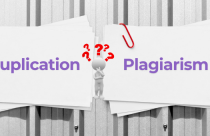The Challenge Of Defining Plagiarism

Defining plagiarism: when you present someone else’s work as your own, you are committing an act of fraud. The website plagiarism.org identifies ten most common types of plagiarism, and ranks them according to their severity:
- CLONE – submitting someone else’s work, word-for-word, as your own.
- CTRL-C – significant portions of text are cut and pasted from a single source without alterations.
- FIND-REPLACE – key words and phrases are changed to disguise the use of someone else’s material, but the essential content of the source material is retained.
- REMIX – paraphrases from multiple sources are made to fit together.
- RECYCLE – borrows generously from the writer’s own previous work without citation (self-plagiarism).
- HYBRID – combines perfectly cited sources with copied passages without citation.
- MASHUP – Mixes copied material from multiple sources.
- 404 ERROR – includes citations to non-existent or inaccurate information about sources.
- AGGREGATOR – includes proper citation to sources but the paper contains almost no original work.
- RE-TWEET – includes proper citation but relies too heavily on the text’s original wording and/or structure.
The consequences of such acts can vary from a simple correction, a public retraction and correction (if your work is published), or more serious legal consequences depending on the plagiarism policies of your academic institution. The ramifications of this misconduct can be avoided by using plagiarism detection tools.
Determination of Intent
The challenge of defining plagiarism lies not in recognizing that the work has been presented without appropriate citation, but in determining the extent to which that failure was deliberate or not. Plagiarism.org’s ranking according to severity accurately captures the different levels of intent. A one hundred percent match score from any text-matching software provides solid evidence that the plagiarism was deliberate. However, should the desperation or laziness of a #1 word-for-word cut-and-paste carry more or less of a penalty than, say, a #6 Hybrid, where the writer may well have deliberately attempted to bury some plagiarized material into a paper with some perfectly cited sources in order to throw readers off the scent? In either case, the text-matching software will probably catch them, but is there a significant difference of intent?
Unintentional Plagiarism
Even with clear notification in the course syllabus or journal submission requirements that text-matching software will be used to verify authorship, plagiarism continues to be a problem in academic writing. Students under deadline pressure will gamble that a professor under similar deadline pressures won’t use the software. Sometimes they’ll get away with it, but most often they do not. For many papers, the plagiarism may not even require the use of software. Students underestimate the extent to which a well-written paragraph will stand out in a poorly constructed paper.
However, the waters get a little murkier when an argument can be made for unintentional plagiarism: incorrect citation, incorrect placement of quotation marks, and failing to cite a sentence or two based on a misunderstanding of fair use, are all examples of plagiarism, but do not carry the same implication of intent. A researcher submitting a paper to a journal that requires a different style than the researcher has used in the past, is likely to make numerous errors in the submission and get flagged for plagiarism. Should that researcher have used proofreading services with the required style guide? Yes, but does the fact that he or she did not automatically make him or her guilty of plagiarism?
One Size Does Not Fit All
As institutions and journals continue to beef-up their plagiarism policies to protect themselves from litigation, we are in danger of losing sight of how many variables may be involved in a plagiarism case. Divination of intent is clearly not easy, and while we can pursue ranking scales of severity, we cannot overlook the possibility that what is needed is re-education rather than automatic punishment. Therefore, part of that examination of intent should include verification of what the researcher has been taught about plagiarism in prior courses.
In conclusion, irrespective of whether it’s a blatant “clone” or a less obvious “hybrid” or “remix,” understanding the various types and levels of plagiarism is crucial for maintaining the integrity of academic work. The best way to prevent the consequences of academic misconduct including plagiarism is to proactively proof-read the manuscript and perform a thorough plagiarism check before submission.
This is where plagiarism detection tools become indispensable. Tools and services like Turnitin checker and Enago’s plagiarism detection tool offer a reliable solution for researchers and students to check their work against an extensive database of academic sources, ensuring that they catch potential issues before submission. The best part is that these tools detect even subtle forms of plagiarism, helping you identify unintentional errors, while also ensuring that all citations are correctly placed and formatted according to the required style guide.










Excelente! Independente do tipo de plágio, penso que este sempre estará relacionado com a falta de educação formal ou informal.
Very clear! Thanks a lot for so useful content!